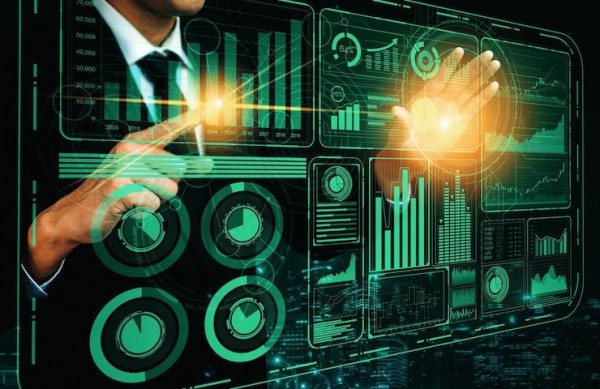Introduction
Generative AI Trends has been a propulsive force behind changing education, offering novel ways for students to learn and for teachers to teach. The beginning of AI in education may be said to have begun in the early 2000s as adaptive learning systems began to provide students with individual resources and feedback. Since then, so much has changed with the rise of further developed and sophisticated technologies that can help in enhancing not only the method of teaching but also learning experiences.
According to a survey, 60% of Educators Use AI in Their Classrooms. Today, Generative AI is taking this transformation further. Generative AI, referring to technologies that can develop text, audio, and images, has increasingly become a part of education. Educators tap Gen AI to create personalized learning resources, automate administration, and provide simulations and virtual environments to students. As we are approaching the year 2024, the rate of changes in the trends of what Gen AI is talking about is fast-paced and promises to revolutionize the educational system.
1) Generative AI-Powered Content Creation
AI is revolutionizing the way content is created for education; Generative AI systems ensure that content creation is far more efficient besides production being optimized. Now, with the power of Generative AI, these systems create detailed textbooks, dynamic quizzes, and interactive courseware — all with minimal human input. These technologies produce new content that is coherent and contextually appropriate to applicable curriculum standards and the goals of a course after analyzing its existing educational resources.
Here’s how integration of AI in content creation is vital.
- Time Efficient: AI makes the content-creation process insanely fast, allowing educators to update and create materials virtually as quickly as needed.
- Enabling Personalized Content: Content can be delivered in ways reflecting the many ways students prefer to learn, and teachers vary its level of difficulty to make it accessible for a diverse population of students.
- Scalability: Use of AI can easily guarantee that educational resources are scaled up to cover the increasing number of learners without a corresponding increase in cost of production.
- Innovation: AI supports the use of multimedia and interactive components, and it is through the process of learning that students are engaged better.
2) Personalized Learning Experiences
Among the leaders in the personalization of learning are generative AI and intelligent learning. The approach to education differs from learner to learner as it aims at meeting the needs of an individual student. Through the analysis of data on student performance, preferences, and learning pace, AI algorithms can develop customized lesson plans and resources that maximize the learning experience of every student. This approach supports mastery in subjects and also supports identifying and solving the weaknesses of an individual.
Adaptive Tutoring Systems and Intelligent Learning Platforms
Key components of personalized learning include:
- Adaptable Tutoring Systems: These systems apply AI-driven responses based on student inputs to offer feedback and guidance. They can also change the difficulty level and format of content based on real-time performance to ensure the engagement and challenge of students.
- Intelligent Learning Platforms: Learning platforms with AI-built algorithms provide a view on all the learning that is integrated with all resources such as video clips, quizzes, and interactive learning resources for a complete and unique learning experience. Some of the features in these platforms include progress tracking, prediction analytics, and tools for motivation to enhance deep learning.
3) AI-Enhanced Language Learning
Generative AI now performs magic in how a person learns a language. This is in customized educations that will help one learn exactly what they need to know. The AI-driven programs provide fully integrated lessons that improve speaking, listening, and writing skills through an incredible number of interactive and engaging ways. These are powered by advanced algorithms that evaluate a learner’s level of proficiency and learning approach, then provide specially designed exercises that guarantee effective learning.
Notably, most of these platforms offer real-time language translation and pronunciation feedback. As the learner is speaking or typing, the AI immediately provides suggested corrections and comments to make the learning of a new language more accessible and efficient. More than that, this feature allows learners to improve significantly on their pronunciation and fluency since the feedback is real-time. Say, for example, that within the multi-cultural education landscape or working in an international company, such a tool can significantly boost the pursuit of effective communication and collaborative work. AI-powered tools, therefore, are not just learning equipment. They also become tools for developing global ties.
4) Virtual Teaching Assistants
Again, this application of AI in education has a virtual context. AI-powered teaching assistants are now integral to the work being done by teachers or instructors. Virtual teaching assistants, having AI and NLP working for them, will help a teacher with lesson preparation, classroom management, and even student interaction in Q&A sessions. These AI assistants can understand and respond to students’ queries in natural language, making them an accessible point of first contact for learning support. This greatly relieves human educators of the routine burden of such tasks, allowing them to invest more time and effort in high-impact teaching and in building relationships with students.
5) Automated Assessment and Grading
More sophisticated uses of generative AI tools automate the evaluation of student work such as essays, problem-solving tasks, and even creative projects. Such AI-driven systems would provide feedback and grades instantly, based on deep analysis of the content, use of references, clarity of the argument, and even stylistic aspects. Indeed, they unburden teachers from a vast amount of time and work, which can now be directed toward more interactive and individual teaching.
Furthermore, AI-type systems also make plagiarism detection more credible. Such systems peruse the content for matches within those in the huge base of sources that can possibly indicate plagiarism. These AI systems are integrated into educational settings in order to secure a high level of academic integrity and to provoke original thinking in students. To make the assessment practices fair and accurate, all AI algorithms always undergo improvement with various datasets to decrease the biases toward diverse learning modalities of the student and their background.
Conclusion
The integration of generative AI into educational systems presents a transformative shift in how educators teach, and learners absorb knowledge. Such trends can signify promise for personalized learning experiences, extending creative and analytical abilities, and more openness to the best educational opportunities from all over the world. As AI tools become more sophisticated, the educational ecosystem must evolve, accommodating new methods of delivering content and assessing student performance.
STL Digital through convergence of 5G, Generative AI, VR technology, Edge and Cloud computing helps revolutionize education, offering unparalleled possibilities for academic institutions to reimagine how they engage with teachers and students.



